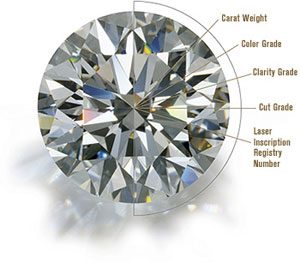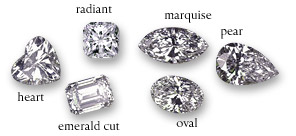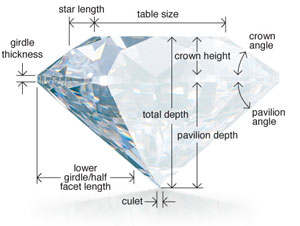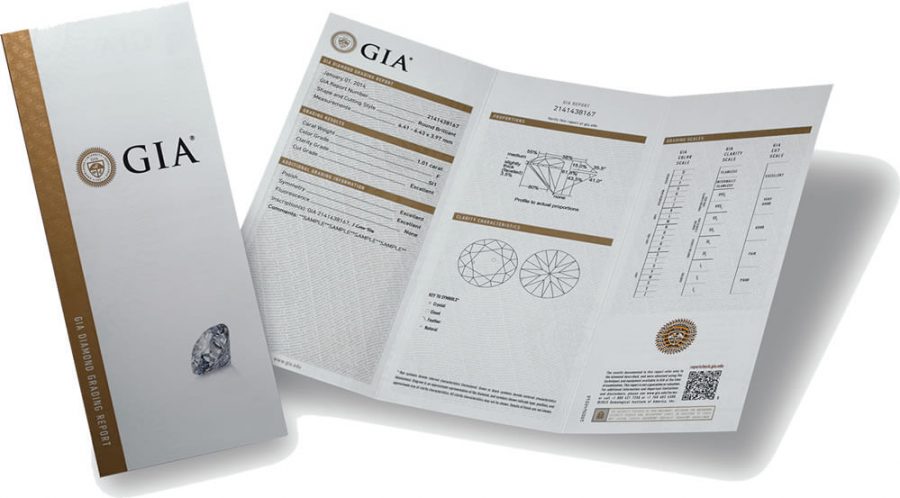Education
 GIA wants you to understand exactly what you’re buying when shopping for your diamond. As creators of the 4Cs and the International Diamond Grading System™, GIA set the standards for diamond grading and has been helping consumers make educated diamond buying decisions for over 50 years.
GIA wants you to understand exactly what you’re buying when shopping for your diamond. As creators of the 4Cs and the International Diamond Grading System™, GIA set the standards for diamond grading and has been helping consumers make educated diamond buying decisions for over 50 years.
![]() GIA’s D-to-Z color-grading scale, Flawless-to-I3 clarity-grading scale, and Excellent-to-Poor cut-grading scale are recognized by gem and jewelry professionals everywhere. And, by extension, the GIA Diamond Grading Report, Diamond Dossier®, and Gemological Identification Report are considered to be the world’s premier evaluations of gem quality and authenticity.
GIA’s D-to-Z color-grading scale, Flawless-to-I3 clarity-grading scale, and Excellent-to-Poor cut-grading scale are recognized by gem and jewelry professionals everywhere. And, by extension, the GIA Diamond Grading Report, Diamond Dossier®, and Gemological Identification Report are considered to be the world’s premier evaluations of gem quality and authenticity.
4C’s Videos
Carat
Clarity
Color
Cut
Shapes and Cutting Styles

Diamonds can be polished into numerous shapes and cutting styles other than the traditional round brilliant cut. While round diamonds are cut to exacting proportions, this is not true of fancy diamonds. Two important factors are that the facets should be well aligned, and that the shape outline should be visually pleasing. While the round brilliant cut is by far the most common and the most brilliant, the selection of one shape over another is a matter of personal choice.
Carat Weight and Size
Diamonds are measured in carat weight, with each carat equaling 100 points. For example, a 0.75 carat diamond is the same as a 75-point diamond or a 3/4 carat stone. The carat weight, or mass, of the diamond is an important determiner of value. The larger the diamond, the more rare it is, therefore, the more valuable.
Carat weight, while important, is only one aspect of value. A large stone holds little value if it lacks brilliance, purity and the proper cut.

Diamond Weight Tolerances
U.S. law allows a half-point tolerance measured to a carat (0.001) and rounded to the nearest hundredth (0.01). Example: 0.995 carat can legally be described and sold as a one-carat diamond in the United States. International trade and G.I.A.’s GemTrade round up to the next higher hundredth only from nine thousandths of a carat. Example: 0.999 carat = 1.00 carat, 0.998 carat = 0.99 carat.
Clarity

Every diamond is unique and possesses it’s own individual natural characteristics referred to as inclusions and described as “nature’s fingerprints.” Clarity is determined by the degree to which a diamond is free of these natural inclusions. The fewer the natural inclusions, the higher the grade and the greater the value of the stone. Most diamonds contain some inclusions (visible only through a 10x magnifying loupe). The number, size, position, nature and color of the inclusions determine the clarity of the diamond. Major inclusions can interfere with the path of light which travels through a diamond, diminishing it’s sparkle and brilliance.
Color
While diamonds often appear colorless, they may actually contain subtle yellow or brown tones that will affect their value. The closer a diamond is to colorless the more valuable it becomes. Diamonds with no hint of color are very rare. Diamond color grades start at D (colorless) and continue through Z (light yellow/brown).

Diamonds having vivid “fancy” colors – reds, blues, pinks and bright yellows – are extremely rare and highly prized.
Cut and Proportions
A diamond’s cut is the most important characteristic. While nature determines a diamond’s carat weight, clarity and color, it’s the hand of the diamond cutter that releases the stone’s fire, sparkle and beauty.
In the industry, diamantaires refer to “make” when they speak of cut and proportion, i.e. excellent, fine, top, good. A “well proportioned” diamond refracts light from one facet to another, creating a shimmering brilliance. Diamonds that are cut “too deep” or “too shallow” refract light out the bottom, causing the diamond to lack brilliance.

So, when shopping for diamonds, pay particular attention to cut because with all things equal, a greater carat weight doesn’t necessarily mean you’re getting a better value. The cut of the diamond is the determining factor.
Certification
The Gemological Institute of America (GIA) is one of the most trusted names in the industry. The GIA is an unbiased, non-profit organization which established the world’s most recognized and accurate system for grading diamonds. While GIA is the most widely known laboratory, there are numerous other laboratories which are both reputable and accurate, including the American Gem Society (AGS), the Diamond High Council (HRD) and the International Gemological Institute (IGI). These certifications are quality reports and do not establish values.

Glossary
AGS – American Gem Society, a professional society created to aide in the promotion of high standards of ethics, education and service.
Blemish – an external flaw (scratch or abrasion) on the surface of a diamond, usually only affecting the polish grade.
Brilliance – white light reflected up through the surface of a diamond.
Brilliant Cut – cut with facet arrangement radiating out from the center, utilizing triangular or kite-shaped facets.
Bearding – tiny feathers extending in from the girdle edge.
Bruise – surface crumbling, often accompanied by tiny, root-like feathers.
Bruting – Cutting step involving rough diamonds which produces the basic shape outline.
Carat – a standard unit of measure for diamonds and other gemstones. One carat is usually expressed as 100 points, a 0.50 ct. as 50 points, etc.
Cavity – a large or deep opening on the surface of a stone, usually angular in appearance.
Chip – a small, large, deep or shallow opening, usually curved or rounded in appearance, often at the girdle edge.
Clarity – the degree to which a diamond is free from inclusions and blemishes.
Clarity Enhancement – an artificial process for improving the clarity of a stone.
Cleavage – an internal growth characteristic that runs in the direction of the grain of the diamond.
Cloud – a group of very small pinpoint inclusions that can be confined to a small area or spread throughout the stone. In some cases, may cause a milky or hazy appearance.
Color – the relative position of a diamond’s body color on a colorless to light yellow scale, denoted by letters (i.e., D to Z, where D is colorless and Z is light yellow) on the GIA color scale, or by numbers (i.e., 0 to 10, where 0 is colorless and 10 is light yellow) on the AGS color scale.
Color Enhancement – laboratory processes ranging from a simple colored coating to a sophisticated permanent alteration of certain trace elements naturally found in a diamond.
Culet – a facet which is usually placed on the point of the pavilion mainly for protection from chipping. The culets of older, European-cut diamonds can be seen through the table of the diamond and appear as round, glassy discs. The preferred culet is visible only as a tiny focal point where the facets of the pavilion converge.
Cut – commonly used to refer to both the outline shape of a stone (round, pear, oval, etc.) and cutting proportions.
Cutting Style – faceting arrangement utilized in fashioning a gemstone, i.e., brilliant cut, step-cut or mixed-cut.
Depth – the height of a diamond (measured from the culet to the table).
Depth Percentage (%) – the depth of a diamond divided by the width of the diamond.
Dispersion – (See Fire)
EGL – European Gemological Laboratory: A franchise diamond grading facility.
Eye-clean – a clarity grading term for diamonds that have no inclusions visible to the unaided eye.
Extra Facet – a facet added to a diamond in addition to the required facets for a particular cutting style.
Facet – the flat, polished surfaces on a diamond.
Feather – a fracture within a diamond that resembles a feather.
Fire – the separation of white light into the spectral colors due to differences in the refraction of the various wavelengths. Also known as dispersion.
Finish – general category describing the aspects of polish and symmetry.
Fluorescence – a glow, usually of a bluish color, but sometimes in white, yellow, or yellow/orange hues, which emanates from certain diamonds when exposed to ultraviolet light.
Fracture – irregular step-like or splintery breaks in a diamond along a direction other than a cleavage plane.
Fracture Filling – an artificial clarity enhancement process in which an inclusion is injected with filler material to mask its presence.
GIA – Gemological Institute of America: a nonprofit institution established in 1931 to serve educational needs of the jewelry industry.
Girdle – the setting edge around the width of a diamond.
HRD – Hoge Raad voor Diamont (Diamond High Council) a nonprofit organization of the Belgian diamond industry, founded in 1973.
Hearts & Arrows – a trade name for the optical phenomenon observed within a diamond utilizing filtered light whereby “hearts” and “arrows” can be seen in the crown and pavilion.
Ideal Cut – “Ideal” also known as the “American Ideal Cut”, a cutting style that is based on the Tolkowsky theoretical brilliant cut diamond.
IGI – International Gemological Institute – Provides diamond and colored stone grading reports and appraisals. Offices located in New York, Antwerp, and Thailand.
Included Crystal – a mineral crystal contained in a diamond.
Indented Natural – a natural that penetrates the stone.
Internal Graining – internal indications of irregular crystal growth; can appear as faint lines, streaks, or have a milky appearance.
Inclusion – any of several types of clarity characteristics, which are found internally within the gemstone.
Knot – an included diamond crystal that reaches the surface of a finished stone.
Laser Drilling – an artificial clarity enhancement process in which a laser is used to drill to an inclusion within a diamond which is then bleached to appear white.
Laser Inscription – a technique to hallmark, brand or inscribe the edge of a diamond with a serial number or other inscription.
Make – the proportions to which a diamond has been cut. A good make will have proportions that maximize the brilliance and fire of a diamond. A poor make will lead to a diamond that has little sparkle due to the inability of the cut to properly reflect light.
Measurement – the dimensions of a gemstone, expressed in millimeters (i.e., height, width, and depth).
Melee – diamonds that weigh less than 1/5 of a carat (0.20 ct. or 20 points).
Natural – part of the original crystal surface remaining on a finished gemstone.
Needle – a long, thin, included crystal.
Pavilion – the bottom portion of a diamond, just below the girdle.
Pinpoint – a very small inclusion, seen under 10X magnification as a very tiny dot. Pinpoints can be single or in groups.
Point – a weight measure equal to one one-hundredth of a carat. (A 0.50-carat diamond is equivalent to 50 points).
Polish – a grade given to the external finish of a stone. The polish scale ranges from poor to excellent.
Proportions – general category describing the various cut parameters of a gemstone.
Report – refers to a diamond grading document detailing unique characteristics of a diamond.
Shape – the outline of a diamond expressed as round, oval, marquise, emerald cut, etc.
Sight Holder – diamond dealer or manufacturer invited by the Central Selling Organization (CSO) to buy rough or uncut diamonds at a “sight” or inspection.
Symmetry – a grade given to the overall uniformity of a stone’s cut. The scale for symmetry ranges from poor to excellent.
Surface Graining – surface indication of the crystal’s structural irregularity.
Table – the large, flat, octagonal facet on the top of a diamond.
Table Percentage – the width of the table divided by the total diameter of the diamond.
Ultraviolet Light – used as a means of detecting fluorescence in gemstones.

